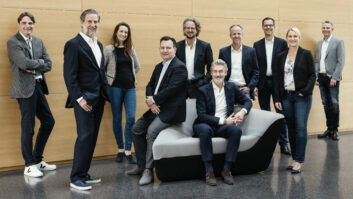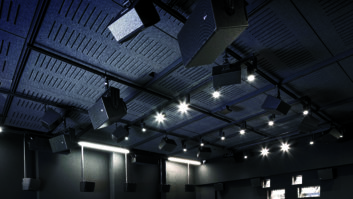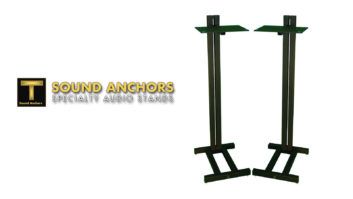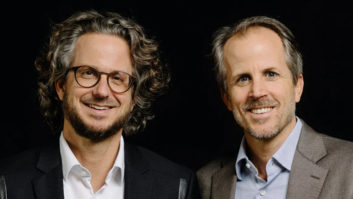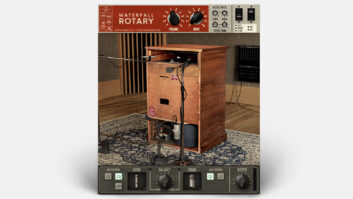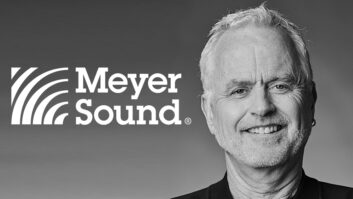Q: How long have you been with Sennheiser?
A: I’ve been with Sennheiser for 10 years now. Actually I’ve been with the company much longer, at least in a kind of mental position because I studied electronics and electroacoustics with Fritz Sennheiser in the mid-’70s when he was still teaching at the university. I remember that his lecture about electroacoustics was one of the very tough ones.
When I came in one morning, I was kind of a little bit late and he said, “Well, if it starts like that, how is that going to end?” When I reminded him of that when I had my first interview with him [at Sennheiser] in ’94, he said, “Oh, I said that?” But the thing that I remember was he [admonished my tardiness] kind of seriously, but still you know, the twinkle in the eye was there, that’s one of his big personality [traits].
He’s a very fierce guy, he’s a very tough business guy, but he’s a very human guy and for him the human relationship is something that’s extraordinarily important and that’s part of the company. For more than 30 years mentally I was there. I had an MD421 and a Sennheiser headphone as a young boy and did my tape recordings with that–which everybody had to have who considers himself serious enough.
Rolf Meyer (left) with the Scorpions at Sennheiser’s recent 60th Anniversary gala in Hannover, Germany.Q: In what job did you start with Sennheiser?
A: When I started my first job it was that of a technical manager. Sennheiser at that time was in the process of redefining its organization. Jörg Sennheiser, who had been the minister of everything, decided that in a time when the company’s growth was really starting to pick up, it needed a different kind of an organization. He was dividing the company into three major areas–marketing and sales, manufacturing and development and finance. So when he hired me, I got the job as a technical manager. After another person came on board for marketing and sales, he decided that this team was now, let me say, well enough groomed that it could be time for him to retire which he then did at the end of ’95.
Q: How involved in the business is the Sennheiser family at this time?
A: The family still owns the business, Jörg Sennheiser still is the Chairman of the Board. He works, I would say more in the role of a Bill Gates, [addressing] the strategic, especially technical issues, representing the company–which is a tremendous asset. If you look at the way a company looks when there still is a Mr. Sennheiser, [it shows] that the company is really at the heart of the family. It’s a family business, and the whole company works like a family business.
He [Jörg] works as the ambassador, the elder statesman. His father, Fritz Sennheiser, still comes into the company once or twice a week, says hello. He never talks business. He says, “I left the business in 1982, let me take a look at what’s going on, but please, let’s have a cup of coffee, let’s talk a little bit about general things.” But for us it’s important because he’s still around. He’s an icon. With his personality, with his humor, with his spirit, at 93, everybody just respects and admires him very, very much.
Q: You say that the company as a whole functions much like a family?
A: Yes. The relationship of the company is not that of people having a job. The company is of people working as part of a whole team, as part of a family. It comes, of course, basically from the background of the company–having built this company in a rural area where really everybody knew each other. All these people lived together. There was a long time [period] when the company would have a lunch break, people would walk home and have lunch at home. Which, today, with the size of the company, isn’t do-able anymore, but still a lot of that remains. People know each other, people talk to each other, and it’s a big [group] spirit.
One of our friends in the industry said it one day. He said, “You guys have a spirit.” This is the one thing that I think differs very much from what other companies have. It’s nothing that you can implant. It’s nothing that you can manage. It’s something that you have to live in. People at Sennheiser work together–if they do whatever they can to make this whole thing successful, they then enjoy the success. Like we say, we work hard and we party hard.
Q: So you would say, as the family grew the business, they really grew the family in many ways?
A: They really grew the family. It’s a different kind of work environment. When you come into it you talk to each other in a different way. You have business objectives, but you talk about the business objectives in the sense of “It’s my affair, it’s part of my own life, it’s part of the way I work.” In the days when Sennheiser took over Neumann in the early ’90s with all the hardships that came with Neumann–because you know, the Neumann story was very sad story, and Sennheiser really had to pick up the bits and pieces–which was extremely hard for the family, for the whole business. People stuck together, and out of it everybody made a tremendous success.
Q: The industry owes you a debt of gratitude for maintaining the integrity of the Neumann line, as well as simply keeping them in business.
A: This is [about] quality. You see, when you talk about quality today many people talk about measuring quality and I say, “Well, it’s great, you can always measure quality.” When I got first introduced, in one of my previous jobs at IBM, into all these quality problems in the early ’80s, they were about measuring quality, and IBM spent a lot of money on that until they found out measuring quality isn’t the thing. The thing is to “live” the quality. Have the quality implanted into everybody’s mindset, have everybody work, do the working process every day based on quality understanding. Then you can measure whatever you want, it’s always very good. Because everybody’s part of it.
Q: Sixty years is a pretty significant milestone. Aside from the personnel, to what do you attribute that success from the product and technology side?
A: I think that Sennheiser always, from the first days on, had a very good sense of leading-edge technology. Understanding how to apply technology to the needs of the customer. Understanding also the needs of the customer. Understanding how the customer wants to run his business, but also, of course, working with the customer towards better understanding of how can you apply products to the customer’s business. One of the key issues that I see there is wireless technology. The first Sennheiser wireless microphone was introduced in 1958. Many other companies, if they wouldn’t have had a success by 1965, they would have just dropped this. But Sennheiser maintained their position in the wireless world and educated the customer and showed the customer how within the way the customer works, why this microphone could help the customer tremendously. And look at it today, who wants to work without wireless microphones?
Q: So much so that wireless spectrum use and management is a big issue for your company.
A: Yes, this is a key issue. When we look at the wireless world today, everybody wants to go wireless. Nobody can imagine [working] with wired microphones, dragging a cable behind [them] on the stage. And I think the customers, the end-users, [and] the manufacturers need to make the big community aware that the spectrum is a very rare thing. These three groups have to stick together and work towards preserving this spectrum.
We have this [initiative] called SOS, Save Our Spectrum, which we do here in Europe, and which we, of course, also emphasize very much in the U.S.–talking to our customers to make people aware that without the wireless spectrum, things will look much different in the future on stages. It’s not enough to say, “Oh, go up to 5 GHz, go up to 7 GHz.” Unfortunately, we’re in an environment that is much different than the wireless network environment. We’re in a different environment than many of the data services and this is one of the things that we are trying to make people very much aware of.
Q: Some of those higher frequencies don’t work well in proximity to the human body, as in a handheld wireless situation.
A: It’s 2.4 GHz–that’s why they invented the microwave because the resonance frequency of meat is [the same as] water which is 2.4 GHz. That’s what some people don’t understand. They try to wear Bluetooth headsets, they have the phone on their left hip and then they have the Bluetooth headset on their right ear and suddenly they say, “Oh, my battery’s dead.” No, it’s just there is no connection because of the body absorption. And the higher frequencies go, the more absorption, the more problems you have with steel structures–all kind of metal structures and things like that.
Q: I take it you’re involved with government lobbying on spectrum issues, on both sides of the Atlantic?
A: Yes, this is one of the key things we work on. And we want to raise awareness of the end-users, of the production companies, of the rental companies. They have to get involved. For us it’s one thing, but the big users–the power users–the broadcasting companies, the theaters–they have to put their voice out there and talk about it. We had [a situation] here in Germany a few weeks ago that one of the public media services just announced, “OK, we’re going to do a digital broadcasting service exactly on the same frequency as all the theaters and operas here in Germany work on.” The theaters and the opera houses didn’t say anything about it. So if we wouldn’t have stepped into that, they would have been just suddenly dead, because if you talk about digital broadcasting, you talk about a complete use of the channel and there is not one Hertz left that you can do anything [else] with.
Q: How do you continue to build on 60 years of success? What are the goals and the plans for the future?
A: Well, we have three elements that we work on. A is, of course, we want to have the right employees, the right people to work at Sennheiser, and we educate our people very much. We do a lot of talent search for new people in the area of technology development and things like that. We want to make sure that people who are in this company, that these people can carry the company also into the future.
B, of course, we work very close with our customers because we want to emphasize that what the customer’s needs are–is something that we have to understand very, very early, even at some point in time where maybe the customers don’t understand it yet. For instance, in the field of what we call portable music, MP3, for many, many years this was nothing that people were really interested in. Yes, they had their Walkmans, but if you compare the times of the Walkman to the times today of the MP3 player, this is a completely different thing. The tools, things are going to converge there. Your cell phone will be your digital camera and will be your MP3 player and we want to provide the [transducer] product. That’s why we work with a lot of the leading MP3 manufacturers and, of course, we also work with some of the people that are not in this business yet, like some of the cell phone companies, to provide the right price. [We work with them] before they even have really scoped out what and how they [enter the market], because one of the things that we want to make sure they all understand is that it always ends at the ear. Whatever you have, it ends at the ear. You know, you can think about the most efficient digital product–[but] sorry, when it comes to the ear, it’s analog. And you know, you have to provide an analog signal to the ear drivers and into the head of your customer and that has to be fantastic-sounding–then you win this game. And this is where I think Sennheiser’s future lies.
And the third thing is, we want to stay independent. As a company, Sennheiser is fully family-owned, it has no external debts whatsoever, which makes us able to make our decisions ourselves. We’re independent, we call the shots; we decide if we want to do something, we decide if we don’t want to do something. But it’s with our own decision-making process, not involving people from the outside that probably don’t know anything about our business. I mean, if you want to make a banker today understand what the business of wireless microphones is, you might make him understand today. But tomorrow he’s forgotten about this because he has to take care of oil prices and whatever. We always have maintained the attitude of really being completely independent of that.
Q: There’s an enormous amount of competition in microphones now with the Pacific Rim cranking out product, sometimes copies of very famous Neumann microphones and such in shape and size. How do you combat the market saturation of low-cost products?
A: In two ways. A, if it’s a copy of something that we have, either a design shape on or [a product we have] a trademark on, we legally go after these guys. We have done that in the past. We have even done that a couple years ago together with Shure. In China, we’ve been successful in this respect. If somebody wants to play with our values and use this for his benefit, we don’t like that at all.
The second thing is, we want to make a very good product at a very reasonable price. Affordability. It’s how we introduced the evolution line of microphones, completely automatically manufactured in Germany, without real labor costs in it. It’s material costs, plus it’s the manufacturing line that counts, and I think that way we can still do more in the future to satisfy the needs of the customer. And educate the customer, the semiprofessional, even the more amateur customer, educate this customer on what the value of a Sennheiser microphone is and why it’s probably, for him, a lot more important and a lot easier to spend a few more bucks on a microphone rather than to have something which is cheap.
Q: Are there other new products, new directions for the company?
A: Well you know, the one thing that we’re working very hard on is, as I said, it’s the conservation of spectrum. We will, and we are working very much towards products that are able to put more wireless channels into the same kind of frequency spectrum. We’re also working towards products that allow the [more accurate] reproduction of sound, like in the Neumann line of products, by making the digital transformation, the digitization of the signal, as early as possible, at the capsule where the sound is really created. These are the things that Sennheiser and Neumann are putting a tremendous amount of research into.
Q: Recently you added Klein + Hummel to the brands that are owned by Sennheiser. How did that come about?
A: [We had] somewhat of an emotional connection to Klein + Hummel. Klein + Hummel is a company that is just one week younger than Sennheiser. Klein + Hummel has always been an icon of the electronics industry in Germany. For some years, [Sennheiser has] been selling the Klein + Hummel product in Germany. Some of our other subsidiaries around the world have done the same. We felt that when we saw Klein + Hummel–due to the business structure they were in being part of a foundation that was run by a charitable institution–that this wasn’t really working out. Then we thought, “Maybe we can do something within the scope of this business.” We were trying to look for a partner then. We finally said. “No, we think that we could add [K+H] to the Sennheiser line, it is a very high [quality] product with a very tremendous, good image. But, it’s not well maintained in the field of technology. So, if we add some of the technology, if we add some of the knowledge we have in [Sennheiser] into it, we can make a fantastic brand out of it again.” I think [we ‘ve] already caught a lot of people’s attention, and I think we can continue to work that way and that it will be a great success.
Q: And so you actually came about this kind of organically. It wasn’t like you were actually aggressively looking to expand your product lines?
A: We are a company that works very much based on our business feelings, but our business feelings work much different than the ones on Wall Street. And that’s how we found Neumann, that’s how we found Klein + Hummel, that’s how we found the Sennheiser Communications [division] three years ago which is tremendous success in the field of telecommunications. Because we live in this business and if we commit to it–we won’t commit to something that we don’t really believe in.
But Klein + Hummel is something we really honestly believe in. Neumann is something that–I mean you’ve seen that [as part of Sennheiser] for 15 years now, and it’s a tremendous success, Sennheiser Communications turned into a success after just a year of its existence, and that’s the way we work. Our decisions might take years or they might take five minutes. But we’ll stick to them and we always really carry them through.
Q: Can you break down the global marketplace for Sennheiser–what percentages of your business are in what regions of the world and then break it down vertically in terms of product categories?
A: The key regional area is, of course, the U.S.–35 percent going towards 40 percent, it’s a tremendous part of our business. About 25 percent comes from center of Europe, 20-22 percent from the areas of western, southern Europe and somewhere around 10 percent from all the others. Very strongly growing, of course, is Asia. The Americas and Asia have had over the past years, 5-6 years, always double-digit growth between 12 and 20 percent, and I think this is going to remain [the case]. In products–wireless microphones, wired microphones are more than 40 percent of our business. Around 20 percent of our business is consumer products. Headphones, and then there’s all the other, there’s Neumann, which all have like 6-7-8 percent share of the Sennheiser business. The key is the wired and wireless microphone business and the consumer business.
Q: Do you see that anticipated growth being primarily as market share or extension of product lines?
A: Well, I think it’s both. We work towards products that haven’t been in the Sennheiser line before. There will always be growth if we introduce new products that we haven’t had before–is that taking away market share from others or is that extending our business? I think that the customer becomes more and more aware today that if he invests his money into a quality product he’s much better off and he’s a lot safer in the long term than if he only looks at his budget. We see that in the headset, in the headphone business where again, [there ‘s] tremendous competition from the big Far East suppliers. We have been able to extend our market share tremendously over the last 4 or 5 years, everywhere around the world, and we’ve done this with a quality product, we’ve done that not necessarily always with the cheapest product.
And if you know Sennheiser, you know that we definitely don’t have the cheapest product. And this is something where we say, “The customer understands that, and if the customer wants to buy that, hey, we’ve got to give him the best answer to this, we have to offer him the right product.”
Rolf Meyer spoke with Pro Sound News editor, Frank Wells.
Sennheiser
www.sennheiserusa.com
